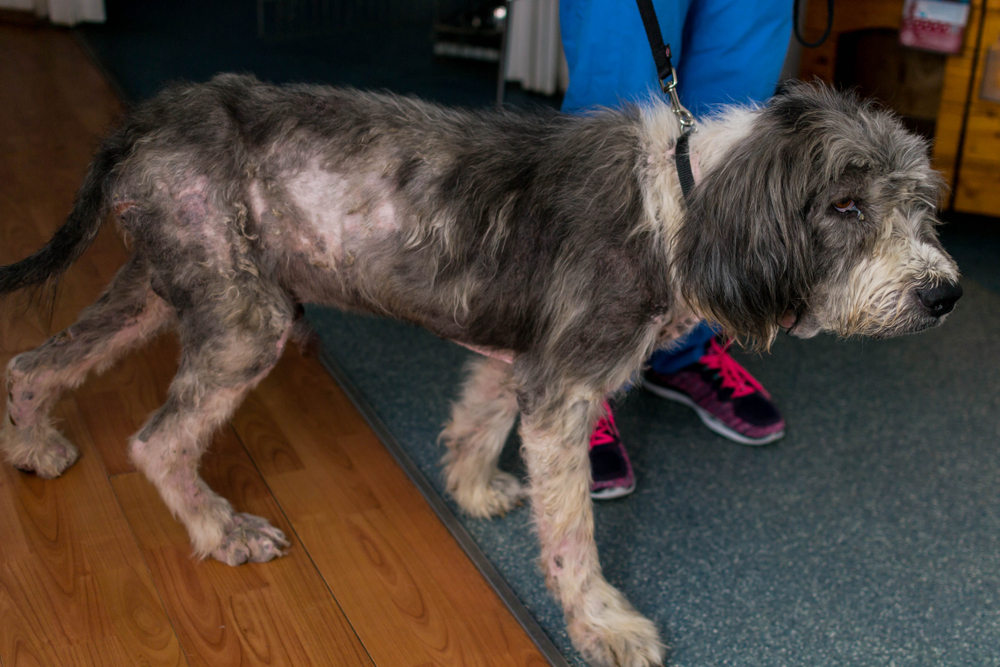When Your Pet’s Coat Starts Thinning: What It Means
Changes in fur texture or bald patches often point to underlying medical issues rather than simple shedding. Common causes include allergies, parasites, or infections. A professional exam identifies the root problem so treatment can begin quickly.
At Twin Maples Veterinary Hospital, our AAHA-accredited team uses advanced in-house diagnostics including cytology, skin testing, and comprehensive blood work to pinpoint the exact cause of coat changes.
What Alopecia Really Means for Your Pet
Alopecia is the medical term for partial or complete hair loss in dogs and cats. While seasonal shedding is normal, distinct bald patches, thinning fur, or excessive scratching signal something more serious. Hair loss (alopecia) can result from skin irritation, hormonal imbalances, parasites, infections, or even emotional stress.
The key difference between normal shedding and true alopecia lies in pattern and persistence. Symmetrical hair loss without itching often points to internal hormonal problems, while patchy, inflamed areas with scratching suggest external irritants or infections. Because alopecia is a symptom rather than a diagnosis, identifying the underlying cause requires veterinary care and often specialized testing.
Why Your Pet’s Coat Is Thinning: Common Causes
Understanding what drives hair loss helps you recognize when your pet needs professional attention. Many conditions share similar symptoms, making accurate diagnosis essential for effective treatment.
Allergies: The Most Frequent Culprit for Pet Coat Thinning
Allergies are among the leading causes of hair loss in both dogs and cats. When pets react to environmental allergens like pollen or dust, food ingredients, or flea bites, their immune system triggers inflammation that causes intense itching. Dogs often chew and scratch at affected areas until the fur falls out, while cats typically overgroom, leaving bald patches on their belly or legs.
Allergies symptoms vary widely, from seasonal flare-ups to year-round discomfort from foods. Flea allergy creates a hypersensitivity reaction where even a single bite triggers severe itching and hair loss along the back and tail base.
Our team at Twin Maples provides comprehensive allergy testing and customized treatment plans that may include dietary changes, medicated shampoos, or prescription medications.
Parasites and Infections That Attack a Pet’s Skin
External parasites and fungal infections cause distinct patterns of hair loss that worsen without treatment. Fleas, mites, and ringworm all create uncomfortable skin conditions that lead to scratching, inflammation, and bald patches.
Spotting and treating mites in dogs requires careful examination, as these microscopic parasites burrow into skin or live in hair follicles. Sarcoptic mange causes intense itching and crusty skin, while demodectic mange creates patchy hair loss without much discomfort. Ringworm, despite its name, is actually a fungal infection that produces circular bald spots with scaly edges.
Indoor pets aren’t immune to these conditions. Diagnosis often requires skin scrapings, fungal cultures, or cytology performed in our in-house diagnostic laboratory. Early detection prevents spread to other pets or family members and allows treatment to begin immediately.
Prevention plays a critical role in managing allergy-related hair loss. The importance of year-round parasite prevention for pets cannot be overstated, as consistent flea control eliminates one of the most common allergy triggers.
Hormonal Imbalances That Affect Pet Coat Quality
When internal glands malfunction, one of the first visible signs is often symmetrical, non-itchy hair loss. Unlike allergy-related alopecia, hormonal hair loss typically occurs on both sides of the body in matching patterns and rarely causes scratching.
Hypothyroidism in dogs develops when the thyroid gland produces insufficient hormones, slowing metabolism and affecting multiple body systems. Dogs with hypothyroidism develop thin, brittle coats, darkened skin, weight gain, and lethargy. Fortunately, daily thyroid supplementation restores normal coat growth within months.
Cushing’s disease causes the opposite problem: excessive cortisol production. Treating Cushing’s disease in dogs requires careful management, as affected pets develop thinning skin, a pot-bellied appearance, increased thirst, and progressive hair loss. The condition most commonly affects middle-aged and senior dogs.
Male dogs with testicular tumors may experience hormone-related hair loss along with behavioral changes and swollen testicles. Neutering typically resolves the issue completely.
Accurate diagnosis of hormonal conditions requires comprehensive blood work. The importance of blood work extends beyond routine screening, as thyroid panels and adrenal function tests reveal internal imbalances before they cause severe symptoms. Our advanced diagnostic capabilities allow us to run complete hormone panels quickly and begin treatment without delay.
Genetic Conditions That Run in Pet Families
Some breeds inherit specific types of alopecia that appear predictably as dogs mature. While these conditions aren’t preventable, understanding breed tendencies helps owners recognize symptoms early.
Color dilution alopecia in dogs affects breeds with dilute coat colors like blue, fawn, or silver. Hair shafts become fragile and break easily, creating a moth-eaten appearance that worsens over time. The condition has no cure, but gentle grooming and moisturizing treatments help maintain coat quality.
Canine flank alopecia creates seasonal bald patches along the sides of the body, typically appearing in fall or winter and regrowing in spring. Breeds like Bulldogs, Boxers, and Airedales develop this cyclical pattern, which may relate to changes in daylight exposure.
Stress and Behavioral Overgrooming
Cats especially are prone to psychogenic alopecia, where anxiety or environmental changes trigger excessive grooming. Unlike medical causes, stress-related hair loss creates symmetrical bald areas without visible skin disease. The belly, inner thighs, and forelegs are most commonly affected.
Feline life stressors include changes in household routine, new pets, moving, or conflicts with other cats. Reducing these triggers through environmental enrichment, pheromone diffusers, and predictable routines often resolves the behavior. In persistent cases, behavioral modification or anti-anxiety medication may be necessary.
Nutrition and Grooming Practices
Poor nutrition weakens hair follicles and creates dull, brittle coats prone to breakage. Diets lacking essential fatty acids, proteins, or vitamins fail to support healthy skin and coat regeneration. Similarly, harsh grooming products or infrequent brushing can damage fur and create the appearance of thinning.
Why pets need regular grooming goes beyond aesthetics. Consistent brushing removes dead hair, distributes natural oils, and allows early detection of skin problems. Our nutrition counseling services help ensure your pet receives balanced nutrition that supports lifelong coat health.
How Veterinarians Identify the Root Cause
Determining why your pet is losing hair requires systematic investigation. During a veterinary wellness exam, we examine the pattern, location, and appearance of hair loss along with any accompanying symptoms like itching, redness, or scaling.
Diagnostic testing may include:
- Skin scraping or tape cytology to identify mites, bacteria, or yeast
- Fungal culture to detect ringworm
- Complete blood count and chemistry panel to evaluate organ function
- Thyroid testing to screen for hormonal imbalances
- Allergy testing or dietary trials to pinpoint environmental or food sensitivities
Our in-house diagnostic laboratory provides rapid results, allowing treatment to begin during the same visit when possible. This comprehensive approach prevents unnecessary treatments and ensures lasting improvement.
Treatment Approaches for Different Causes
Once we identify the underlying issue, treatment targets the specific cause rather than just the symptom. This focused approach produces better outcomes and prevents recurrence.
- For allergies, treatment may combine antihistamines, prescription diets, medicated shampoos, and immunotherapy. Consistent parasite prevention eliminates flea-related triggers entirely.
- Parasitic infections require prescription medications to kill mites or antifungal therapy for ringworm. Environmental decontamination prevents reinfection and protects other household pets.
- Hormonal disorders respond to daily medication that replaces missing hormones or regulates excessive production. Regular monitoring through follow-up blood work ensures proper dosing.
- Bacterial or fungal skin infections clear with appropriate antibiotics or antifungals, often combined with topical treatments that soothe inflammation.
- Stress-related overgrooming improves through environmental modifications, increased play and enrichment, pheromone therapy, or behavioral medications when needed.
Consistent follow-up appointments track progress and adjust treatment as needed. Most pets show visible improvement within weeks once the correct therapy begins.

Protecting Your Pet’s Coat Health Long-Term
Prevention and early intervention keep minor issues from becoming major problems. Simple habits make a significant difference in maintaining healthy skin and coat.
Keep pets on year-round parasite prevention to eliminate fleas, ticks, and mites before they cause problems. Feed high-quality diets formulated for your pet’s life stage and health needs. Brush regularly to remove dead hair and check for skin changes. Most importantly, schedule annual wellness exams that catch hormonal imbalances or infections in their earliest stages.
Getting Your Pet’s Coat Back to Health
Most cases of hair loss resolve successfully once the underlying cause receives proper treatment. Whether the problem stems from allergies, hormones, parasites, or stress, accurate diagnosis leads to effective solutions that restore comfort and confidence.
If you’ve noticed bald patches, excessive scratching, or changes in your pet’s coat texture, don’t wait for the problem to worsen. Our experienced team provides thorough examinations and advanced diagnostics that identify the root cause quickly. Request an appointment today, and let’s work together to bring back your pet’s healthy, shiny coat.









Leave A Comment